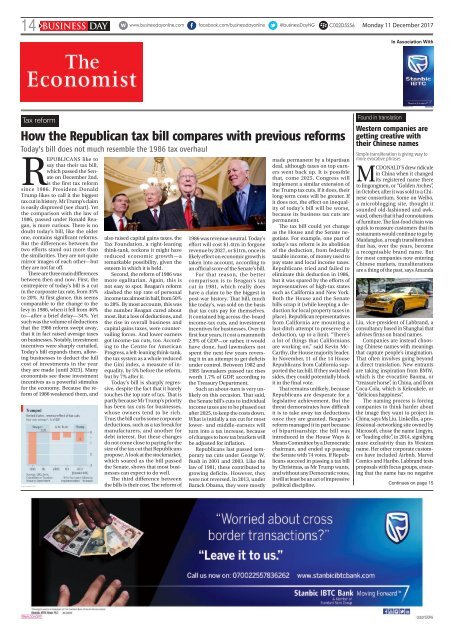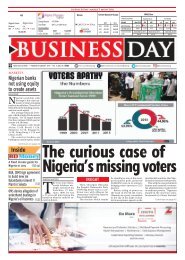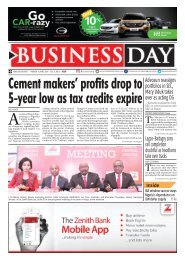BusinessDay 11 Dec 2017
You also want an ePaper? Increase the reach of your titles
YUMPU automatically turns print PDFs into web optimized ePapers that Google loves.
14 BUSINESS DAY C002D5556<br />
Monday <strong>11</strong> <strong>Dec</strong>ember <strong>2017</strong><br />
In Association With<br />
Tax reform<br />
How the Republican tax bill compares with previous reforms<br />
Today’s bill does not much resemble the 1986 tax overhaul<br />
REPUBLICANS like to<br />
say that their tax bill,<br />
which passed the Senate<br />
on <strong>Dec</strong>ember 2nd,<br />
is the first tax reform<br />
since 1986. President Donald<br />
Trump likes to call it the biggest<br />
tax cut in history. Mr Trump’s claim<br />
is easily disproved (see chart). Yet<br />
the comparison with the law of<br />
1986, passed under Ronald Reagan,<br />
is more curious. There is no<br />
doubt today’s bill, like the older<br />
one, contains significant reforms.<br />
But the differences between the<br />
two efforts stand out more than<br />
the similarities. They are not quite<br />
mirror images of each other—but<br />
they are not far off.<br />
There are three main differences<br />
between then and now. First, the<br />
centrepiece of today’s bill is a cut<br />
in the corporate tax rate, from 35%<br />
to 20%. At first glance, this seems<br />
comparable to the change to the<br />
levy in 1986, when it fell from 46%<br />
to—after a brief delay—34%. Yet<br />
such was the volume of deductions<br />
that the 1986 reform swept away,<br />
that it in fact raised average taxes<br />
on businesses. Notably, investment<br />
incentives were sharply curtailed.<br />
Today’s bill expands them, allowing<br />
businesses to deduct the full<br />
cost of investments in the year<br />
they are made (until 2023). Many<br />
economists see these investment<br />
incentives as a powerful stimulus<br />
for the economy. Because the reform<br />
of 1986 weakened them, and<br />
also raised capital gains taxes, the<br />
Tax Foundation, a right-leaning<br />
think-tank, reckons it might have<br />
reduced economic growth—a<br />
remarkable possibility, given the<br />
esteem in which it is held.<br />
Second, the reform of 1986 was<br />
more egalitarian. Again, this is<br />
not easy to spot. Reagan’s reform<br />
slashed the top rate of personal<br />
income tax almost in half, from 50%<br />
to 28%. By most accounts, this was<br />
the number Reagan cared about<br />
most. But a loss of deductions, and<br />
the rise in overall business and<br />
capital gains taxes, were countervailing<br />
forces. And lower earners<br />
got income-tax cuts, too. According<br />
to the Centre for American<br />
Progress, a left-leaning think-tank,<br />
the tax system as a whole reduced<br />
the Gini index, a measure of inequality,<br />
by 5% before the reform,<br />
but by 7% after it.<br />
Today’s bill is sharply regressive,<br />
despite the fact that it barely<br />
touches the top rate of tax. That is<br />
partly because Mr Trump’s priority<br />
has been tax cuts for businesses,<br />
whose owners tend to be rich.<br />
True, the bill curbs some corporate<br />
deductions, such as a tax break for<br />
manufacturers, and another for<br />
debt interest. But these changes<br />
do not come close to paying for the<br />
size of the tax cut that Republicans<br />
propose. A look at the stockmarket,<br />
which soared as the bill passed<br />
the Senate, shows that most businesses<br />
can expect to do well.<br />
The third difference between<br />
the bills is their cost. The reform of<br />
1986 was revenue neutral. Today’s<br />
effort will cost $1.4trn in forgone<br />
revenue by 2027, or $1trn, once its<br />
likely effect on economic growth is<br />
taken into account, according to<br />
an official score of the Senate’s bill.<br />
For that reason, the better<br />
comparison is to Reagan’s tax<br />
cut in 1981, which really does<br />
have a claim to be the biggest in<br />
post-war history. That bill, much<br />
like today’s, was sold on the basis<br />
that tax cuts pay for themselves.<br />
It contained big across-the-board<br />
income-tax cuts, and investment<br />
incentives for businesses. Over its<br />
first four years, it cost a mammoth<br />
2.9% of GDP—or rather, it would<br />
have done, had lawmakers not<br />
spent the next few years reversing<br />
it in an attempt to get deficits<br />
under control. Between 1982 and<br />
1985 lawmakers passed tax rises<br />
worth 1.7% of GDP, according to<br />
the Treasury Department.<br />
Such an about-turn is very unlikely<br />
on this occasion. That said,<br />
the Senate bill’s cuts to individual<br />
income taxes are to be phased out<br />
after 2025, to keep the costs down.<br />
What is initially a tax cut for most<br />
lower- and middle-earners will<br />
turn into a tax increase, because<br />
of changes to how tax brackets will<br />
be adjusted for inflation.<br />
Republicans last passed temporary<br />
tax cuts under George W.<br />
Bush in 2001 and 2003. Like the<br />
law of 1981, these contributed to<br />
growing deficits. However, they<br />
were not reversed. In 2013, under<br />
Barack Obama, they were mostly<br />
made permanent by a bipartisan<br />
deal, although taxes on top earners<br />
went back up. It is possible<br />
that, come 2025, Congress will<br />
implement a similar extension of<br />
the Trump tax cuts. If it does, their<br />
long-term costs will be greater. If<br />
it does not, the effect on inequality<br />
of today’s bill will be worse,<br />
because its business tax cuts are<br />
permanent.<br />
The tax bill could yet change<br />
as the House and the Senate negotiate.<br />
For example, one part of<br />
today’s tax reform is its abolition<br />
of the deduction, from federally<br />
taxable income, of money used to<br />
pay state and local income taxes.<br />
Republicans tried and failed to<br />
eliminate this deduction in 1986,<br />
but it was spared by the efforts of<br />
representatives of high-tax states<br />
such as California and New York.<br />
Both the House and the Senate<br />
bills scrap it (while keeping a deduction<br />
for local property taxes in<br />
place). Republican representatives<br />
from California are mounting a<br />
last-ditch attempt to preserve the<br />
deduction, up to a limit. “There’s<br />
a lot of things that Californians<br />
are working on,” said Kevin Mc-<br />
Carthy, the House majority leader.<br />
In November, <strong>11</strong> of the 14 House<br />
Republicans from California supported<br />
the tax bill. If they switched<br />
sides, they could potentially block<br />
it in the final vote.<br />
That remains unlikely, because<br />
Republicans are desperate for a<br />
legislative achievement. But the<br />
threat demonstrates how difficult<br />
it is to take away tax deductions<br />
once they are granted. Reagan’s<br />
reform managed it in part because<br />
of bipartisanship: the bill was<br />
introduced in the House Ways &<br />
Means Committee by a Democratic<br />
chairman, and ended up passing<br />
the Senate with 74 votes. If Republicans<br />
succeed in passing a tax bill<br />
by Christmas, as Mr Trump wants,<br />
and without any Democratic votes,<br />
it will at least be an act of impressive<br />
political discipline.<br />
Found in translation<br />
Western companies are<br />
getting creative with<br />
their Chinese names<br />
Simple transliteration is giving way to<br />
more evocative phrases<br />
MCDONALD’S drew ridicule<br />
in China when it changed<br />
its registered name there<br />
to Jingongmen, or “Golden Arches”,<br />
in October, after it was sold to a Chinese<br />
consortium. Some on Weibo,<br />
a microblogging site, thought it<br />
sounded old-fashioned and awkward,<br />
others that it had connotations<br />
of furniture. The fast-food chain was<br />
quick to reassure customers that its<br />
restaurants would continue to go by<br />
Maidanglao, a rough transliteration<br />
that has, over the years, become<br />
a recognisable brand name. But<br />
for most companies now entering<br />
Chinese markets, transliterations<br />
are a thing of the past, says Amanda<br />
Liu, vice-president of Labbrand, a<br />
consultancy based in Shanghai that<br />
advises firms on brand names.<br />
Companies are instead choosing<br />
Chinese names with meanings<br />
that capture people’s imagination.<br />
That often involves going beyond<br />
a direct translation. New entrants<br />
are taking inspiration from BMW,<br />
which is the evocative Baoma, or<br />
“treasure horse”, in China, and from<br />
Coca-Cola, which is Kekoukele, or<br />
“delicious happiness”.<br />
The naming process is forcing<br />
companies to think harder about<br />
the image they want to project in<br />
China, says Ms Liu. LinkedIn, a professional-networking<br />
site owned by<br />
Microsoft, chose the name Lingyin,<br />
or “leading elite”, in 2014, signifying<br />
more exclusivity than its Western<br />
name. Her other corporate customers<br />
have included Airbnb, Marvel<br />
Comics and Haribo. Labbrand tests<br />
proposals with focus groups, ensuring<br />
that the name has no negative<br />
Continues on page 15


















